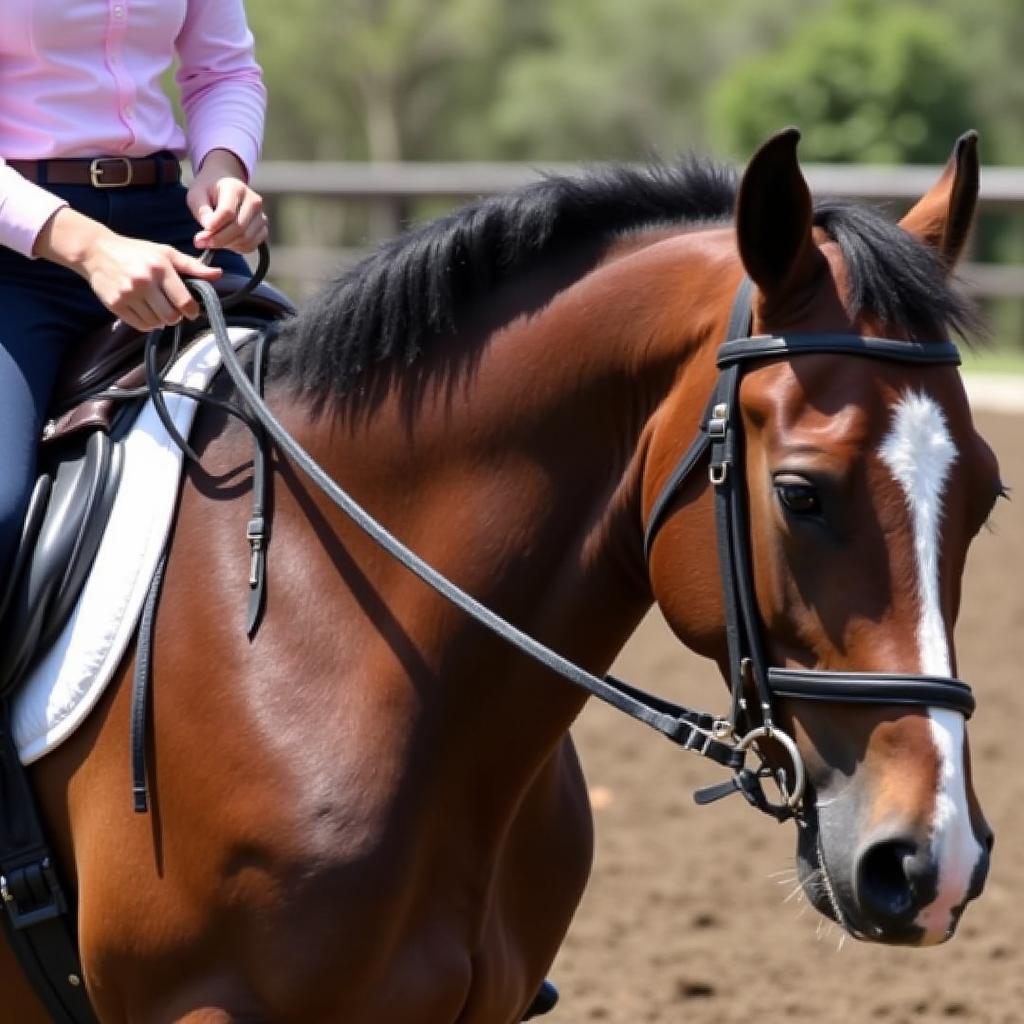Do Horse Riders Ever Cross Their Hands Holding The Reins? It’s a common question, especially among beginner riders. The answer, like many things in horsemanship, isn’t a simple yes or no. There are specific situations where crossing your hands can be beneficial, while in others, it’s generally discouraged. Understanding the nuances of rein management is key to effective communication with your horse.
When Crossing Hands on the Reins Might Be Appropriate
While it’s generally recommended to keep your hands separated and following the horse’s motion, certain circumstances may call for a temporary crossing of the hands. For instance, when making a very tight turn, such as in a small arena or when navigating obstacles, crossing your hands can offer increased leverage and control. It allows for a more pronounced rein aid, helping the horse understand the direction change.
Another instance where crossing hands can be helpful is when working with a young or green horse that’s still learning to respond to rein cues. By momentarily crossing your hands, you can provide a clearer, more direct signal, guiding the horse through the movement.
However, it’s crucial to remember that crossing your hands should be a temporary and deliberate action, not a habitual practice. Over-reliance on crossed reins can lead to confusion for the horse and can hinder the development of independent rein aids.
Why Keeping Your Hands Separate is Generally Preferred
The standard practice in most riding disciplines is to keep your hands separate and relatively still, following the natural movement of the horse’s head. This allows for a softer, more subtle connection and encourages the horse to respond to lighter cues.
Keeping your hands apart also promotes balance and stability for both horse and rider. It allows you to maintain an even feel of the reins and to react quickly to any unexpected movements.
 Separate Hands for Consistent Rein Contact
Separate Hands for Consistent Rein Contact
Do Horse Ricders Ever Cross Their Hands Holding the Reins: Common Misconceptions
One common misconception is that crossing your hands is necessary for turning the horse. While it might feel like it provides more leverage, turning should primarily come from your seat and leg aids, with the reins simply guiding the horse’s head and neck.
Another misconception is that crossing your hands is a shortcut to better control. In reality, it can actually create more resistance and tension in the horse, making it less responsive in the long run. Consistent practice with separate hands, combined with proper leg and seat aids, will lead to much more effective communication and control.
Is Crossing Your Hands Always Wrong?
Not necessarily. As mentioned earlier, there are specific situations where it can be beneficial. However, it’s essential to understand the why and when behind the action, rather than relying on it as a crutch.
How Can I Learn to Use My Reins Effectively?
The best way to develop proper rein handling is through consistent practice and guidance from a qualified instructor. They can help you understand the nuances of rein aids and how to use them in conjunction with your seat and legs for effective communication with your horse.
[do horse ricders ever cross their hands holding the reins](https://justushorses.com/do-horse-ricders-ever-cross-their-hands-holding-the reins/)
Expert Insights on Rein Management
Here’s what some experts have to say:
-
Jane Doe, Certified Riding Instructor: “Crossing your hands on the reins can be a useful tool in specific training situations, but it should be used judiciously and with a clear understanding of its purpose. Overuse can lead to bad habits and hinder the horse’s responsiveness to lighter aids.”
-
John Smith, Equine Behaviorist: “Horses are incredibly sensitive animals. They can feel even the slightest changes in pressure on the reins. By keeping your hands separate and quiet, you can communicate with your horse more effectively and build a stronger partnership based on trust and understanding.”
In Conclusion
So, do horse riders ever cross their hands holding the reins? The answer is yes, but it’s not a standard practice. While it can be helpful in certain limited circumstances, such as tight turns or working with young horses, it’s generally best to keep your hands separate and focused on maintaining a soft, consistent connection. Proper rein management is crucial for effective communication with your horse, and understanding the nuances of rein aids will help you become a more skilled and confident rider.
FAQ
- Is it bad to cross my hands on the reins? Not always, but it shouldn’t be a habit.
- How should I hold the reins? Generally, keep your hands separate and follow the horse’s motion.
- What are the benefits of keeping my hands separate? Better balance, stability, and clearer communication with the horse.
- When might crossing my hands be helpful? In tight turns or when working with a young horse.
- How can I improve my rein handling skills? Practice consistently and seek guidance from a qualified instructor.
- What are other important riding aids besides reins? Seat and legs are crucial for effective communication.
- Can crossing my hands damage my horse’s mouth? It could if done harshly or incorrectly.
For further assistance, please contact us at Phone Number: 0772127271, Email: [email protected], or visit our address: QGM2+WX2, Vị Trung, Vị Thuỷ, Hậu Giang, Việt Nam. Our customer service team is available 24/7.